Top Essential Oils for Hand Foot Mouth Disease: Relieve Symptoms Naturally
When your child is suffering from the discomfort of Hand Foot Mouth Disease (HFMD), finding effective relief becomes a top priority. Imagine discovering a natural remedy that not only alleviates the painful symptoms but also soothes the mind and body. Essential oils for hand foot mouth disease may provide natural relief from symptoms like sores and rashes. This article covers how to use lavender, tea tree, and lemon essential oils safely to soothe HFMD symptoms.
Essential Insights and Practical Tips
- Hand Foot Mouth Disease (HFMD) is a highly contagious viral illness that primarily affects young children, causing symptoms like fever, painful sores in the mouth, and a rash on the hands and feet. Preventive measures include frequent hand-washing and avoiding close contact with infected individuals.
- Essential oils such as lavender, tea tree, and lemon can help treat and alleviate HFMD symptoms due to their anti-inflammatory and antiviral properties. Proper dilution with carrier oils is necessary to ensure safe application, especially for your little one.
- Other natural remedies that can complement essential oil treatments for HFMD include coconut water for hydration, Epsom salt baths for relieving pain and inflammation, and ginger root tea for its anti-inflammatory and immune-boosting benefits. Medical help should be sought for severe or persistent symptoms.
Safety Warning: Always consult a healthcare provider before using essential oils, particularly for young children, to avoid potential allergic reactions or skin sensitivities.
Understanding Hand Foot Mouth Disease

HFMD is a common viral illness that primarily affects young children. It can also occur in adults, although less frequently. This contagious infection is caused by the coxsackievirus, a member of the nonpolio enteroviruses group. HFMD typically manifests as painful sores in the mouth and a rash on the hands and feet, leading to significant discomfort.
A basic understanding of HFMD becomes pivotal in managing and preventing the infection effectively. This disease spreads easily through bodily fluids, close contact, and contaminated surfaces, making it highly contagious in environments like daycare centers and schools. Frequent hand-washing and avoiding close contact with infected individuals are essential preventive measures.
Early identification of signs and symptoms aids in a more effective management of the disease. In the following sections, we’ll delve deeper into the common symptoms of HFMD and the causes and risk factors associated with this infection.
Common Signs and Symptoms
The symptoms of hand, foot, and mouth disease typically manifest 3 to 5 days following exposure to the virus. It is important to be aware of this incubation period when monitoring for potential signs of the illness. The initial signs often include:
- Fever
- Sore throat
- General feeling of being unwell
- Increased fussiness (in infants and toddlers)
- Loss of appetite (in infants and toddlers)
Within one or two days after the fever begins, painful sores can develop in the front of the mouth or throat, making eating food and drinking liquids quite uncomfortable. These mouth sores are a hallmark of HFMD and can cause significant distress, especially in young children. Alongside these sores, a rash may appear on the hands, feet, and sometimes on the buttocks. This rash typically consists of red spots that may develop into blisters, although it is usually not itchy.
A clear comprehension of these symptoms aids in early identification and effective management of HFMD. By recognizing the signs, parents and caregivers can take appropriate steps to alleviate discomfort and prevent the spread of the disease.

Sign Up to Get Your FREE Pets
e-Book Here…
Causes and Risk Factors
HFMD is transmitted through various bodily fluids, including:
- nose secretions
- throat discharge
- saliva
- fluid from blisters
- stool
- respiratory droplets
This ease of transmission explains why HFMD outbreaks are common in child care settings, where frequent diaper changes and hand-to-mouth behaviors are prevalent.
The disease is most commonly contracted through the mouth, making close person-to-person contact a significant risk factor. Contaminated surfaces can also serve as a conduit for the virus, emphasizing the importance of thorough and frequent hand-washing.
Children, especially those aged between 5 and 7, confront a higher risk of contracting HFMD. Their developing immune systems and behaviors that increase exposure to the virus make them more susceptible. A clear understanding of these risk factors aids in implementing preventive measures and efficient management of the disease.
HFMD vs. Foot and Mouth Disease: What’s the Difference?
Hand Foot Mouth Disease (HFMD) is a contagious viral infection primarily affecting young children, characterized by sores in the mouth and a rash on the hands and feet. In contrast, Foot and Mouth Disease (FMD) is a severe viral disease that affects livestock such as cattle, sheep, and pigs, causing blisters on the mouth and feet. HFMD is caused by coxsackie virus, while FMD is caused by a different virus, the aphthovirus, and does not affect humans. Understanding these distinctions is crucial to prevent confusion and ensure appropriate treatment and preventive measures.
Scientific Validation: Empowering You with Proven Remedies
Empowering our choices with scientifically-backed remedies can significantly enhance our confidence in managing health conditions naturally. Here’s compelling evidence from research that underscores the efficacy of essential oils in alleviating HFMD symptoms:
- Anti-inflammatory Properties:
Lavender oil’s renowned anti-inflammatory properties have been scientifically validated, showing its potential to soothe blisters and rashes effectively. Studies have consistently highlighted lavender oil’s success in managing various skin conditions, offering a natural and gentle solution for inflammation-related discomforts1.
2. Antiviral Effects:
Tea tree oil stands out for its potent antiviral properties. Research has demonstrated its ability to inhibit viral replication, providing a robust defense against HFMD outbreaks. By integrating tea tree oil into your regimen, you can leverage its scientifically-proven antiviral capabilities to manage and reduce the spread of the virus2
3. Immune Support:
Lemon oil is not just a refreshing scent; it’s a powerhouse of vitamin C, known for boosting the immune system. Scientific research supports the use of lemon oil to enhance immune function, accelerating recovery from viral infections. Incorporating lemon oil into your health practices can fortify your immune response, aiding in a quicker and more efficient recovery process3.
Essential Oils for Relieving HFMD Symptoms
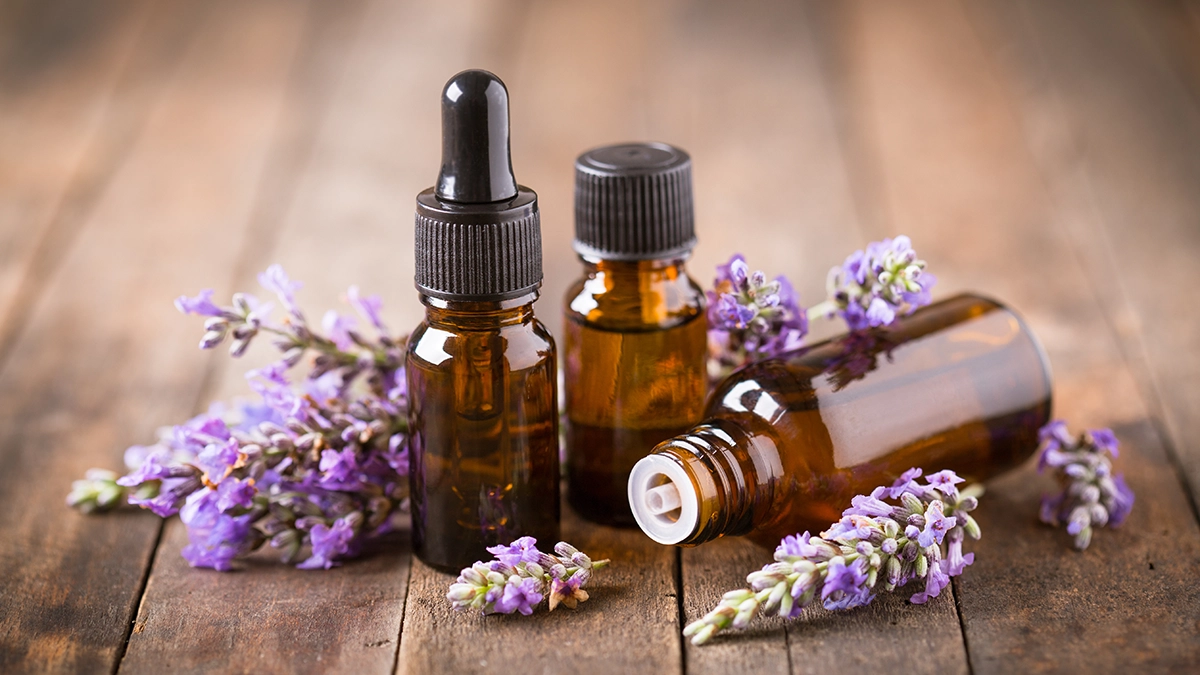
Essential oils, with their anti-inflammatory and antiviral properties, offer a natural and holistic approach to managing HFMD symptoms. Some beneficial oils for HFMD include:
- Lavender: soothes blisters and reduces inflammation
- Tea tree: disinfects affected areas and promotes healing
- Lemon: has antiviral properties and supports the healing process
These oils provide relief and support the healing process, making them valuable tools in the fight against HFMD.
We will now delve into the specific benefits of lavender, tea tree, and lemon essential oils in the subsequent sections. You’ll learn how each oil can be used to alleviate symptoms and promote healing, along with practical tips for safe and effective application.
Lavender Essential Oil
Lavender essential oil is renowned for its calming effects, making it an excellent choice for promoting sleep during HFMD outbreaks. The soothing properties of lavender can help reduce the discomfort of blisters and support overall relaxation, which is crucial for recovery. Croatian Lavender essential oil is particularly high in borneol, enhancing its antiseptic and anti-inflammatory properties.
Applying lavender oil topically can also aid in pain relief and maintain healthy skin balance, making it a versatile remedy for HFMD symptoms. When used in a diffuser, lavender oil creates a calming atmosphere that can help children sleep better, providing much-needed rest during the illness.
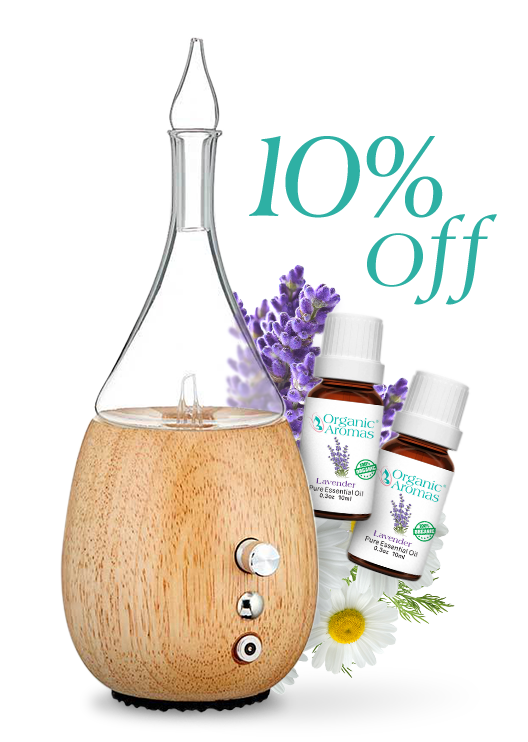
Join Now and Get a Coupon for 10% Off!
Tea Tree Oil
Tea tree oil is celebrated for its antiseptic, antiviral, and antibacterial properties, making it a powerful ally in treating HFMD. The topical application of tea tree oil can help heal mouth ulcers and accelerate the healing process of blisters due to its anti-infective properties.
Using tea tree oil in a safe and diluted form can significantly reduce the risk of infection and promote faster recovery. Its versatile nature makes it a staple in any natural remedy toolkit for HFMD.
Lemon Essential Oil
Lemon essential oil acts as a natural disinfectant, making it an excellent choice for dealing with HFMD. Its antiviral, anti-inflammatory properties, and antioxidant and antimicrobial properties help fight the virus and reduce inflammation, supporting the immune response.
When applied topically, lemon essential oil can nourish the skin and aid in the healing process. Additionally, incorporating lemon essential oil into hand soap or body wash can help fight viruses and infections while maintaining skin health.
How to Use Essential Oils Safely for HFMD
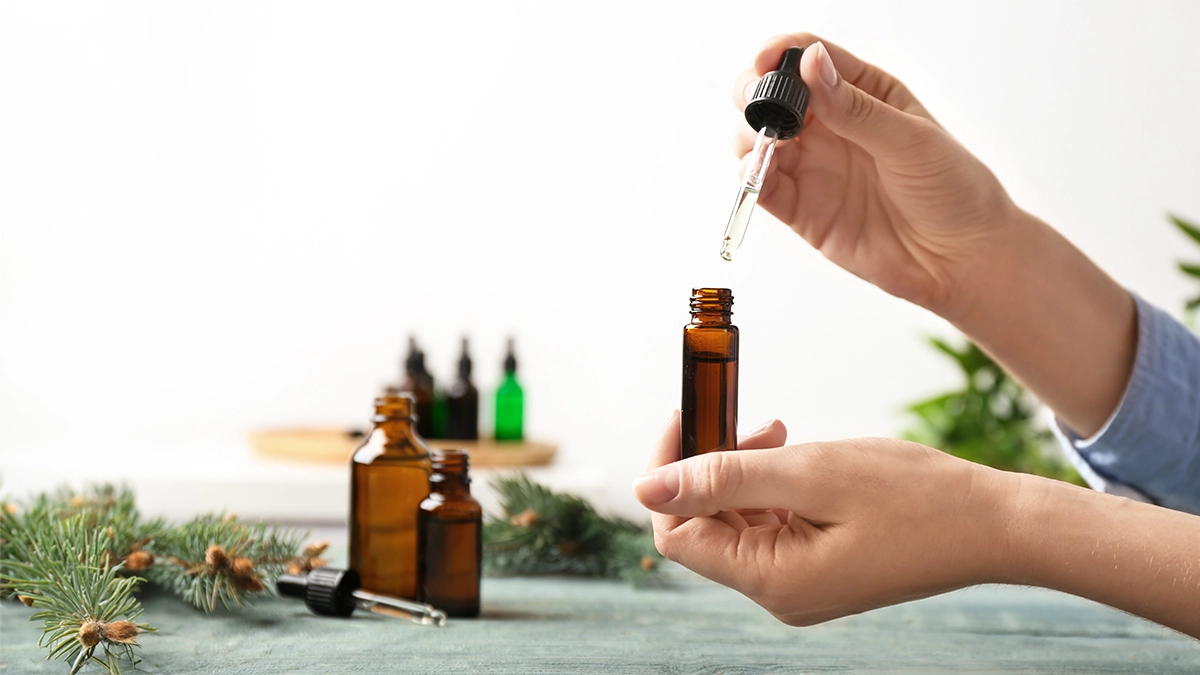
Despite the numerous benefits of essential oils, it’s paramount to ensure their safe usage to prevent adverse reactions, particularly in children. Essential oils should always be diluted with carrier oils before application to prevent skin irritation. They can also be used in a diffuser to create a soothing environment that aids in symptom relief.
Subsequent subsections will focus on the best practices for diluting essential oils, using diffusers, and topical application of oils. These guidelines will ensure that you can harness the healing power of essential oils safely and effectively.
Dilution with Carrier Oils
For the safe use of essential oils, especially in children, their dilution with carrier oils is of utmost importance. Carrier oils like coconut oil, olive oil, or fractionated coconut oil help minimize the risk of skin irritation and make the essential oils more suitable for sensitive skin.
A common dilution ratio for HFMD is a few drops of essential oil per teaspoon of carrier oil. This ensures that the oils are gentle enough for young children while still being effective in relieving symptoms. Always mix the essential oils thoroughly with the carrier oil before applying them to the skin.
Essential Oil Diffuser
Using an essential oil diffuser can create a calming and soothing environment, which is beneficial for those suffering from HFMD. Diffusing oils like lavender can help children sleep better and reduce overall discomfort during the illness.
A nebulizing diffuser, in particular, is effective in creating an atmosphere that is inhospitable to viruses, mold, and bacteria, potentially enhancing the immune system’s ability to fight off infections.
Topical Application
The topical application of essential oils requires particular caution, notably when used on children. Stronger oils like clove and oregano should be avoided for young children due to their potency.
When applying essential oils topically for HFMD, ensure the mixture is spread evenly across the affected areas. Tea tree oil, known for its anti-infective properties, can be particularly effective in supporting the healing of mouth ulcers.
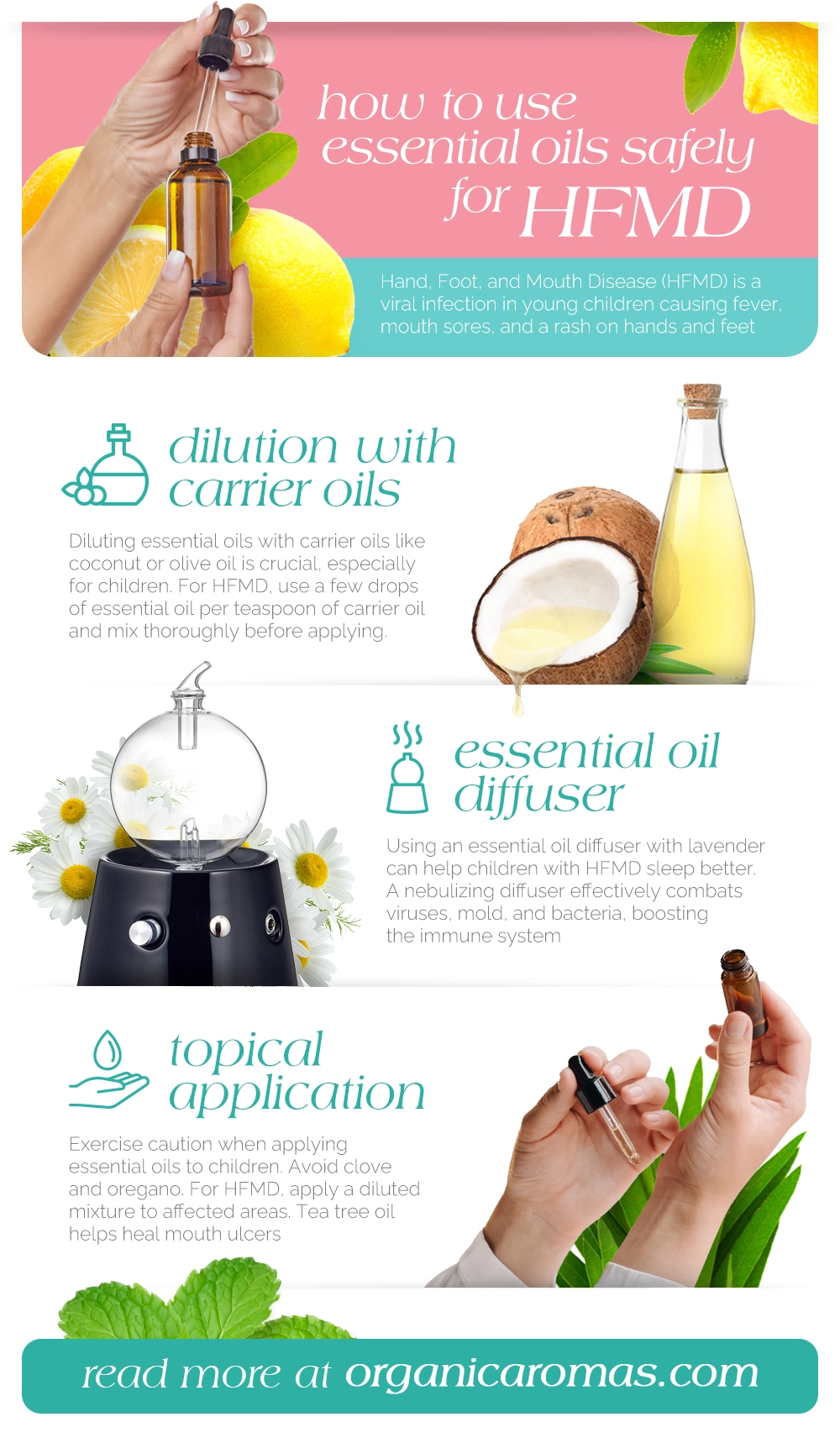
DIY Essential Oil Blends for HFMD Relief
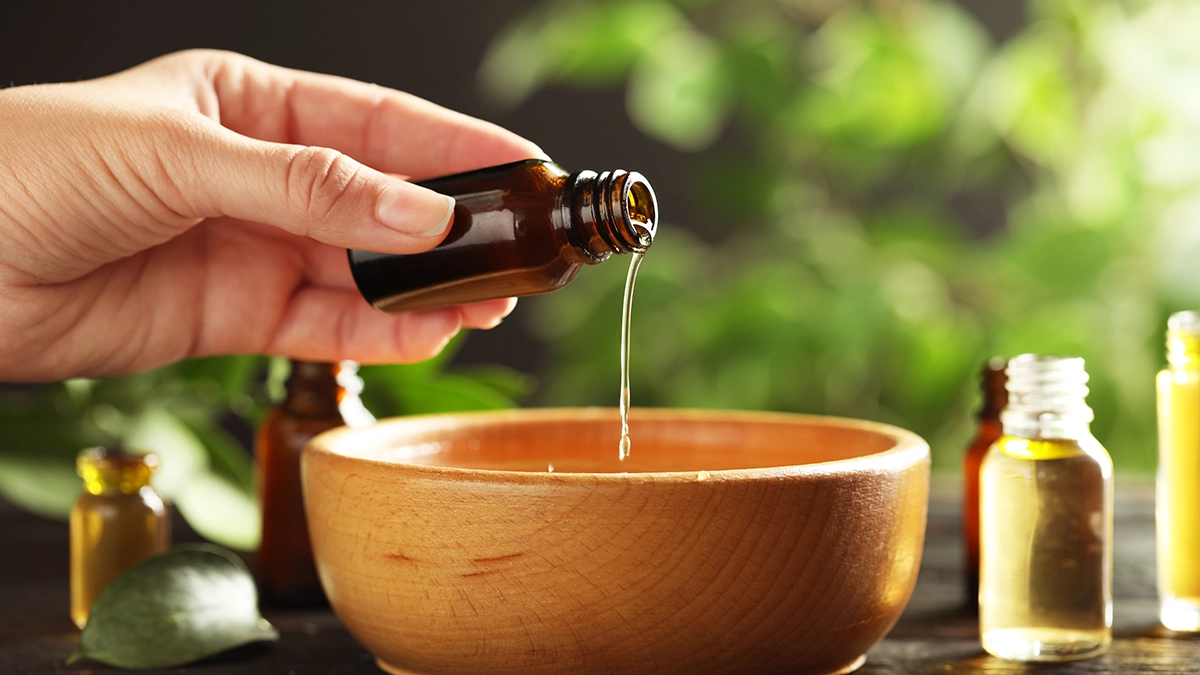
Creating your own essential oil blends can provide targeted relief for HFMD symptoms. These DIY blends combine the therapeutic properties of multiple essential oils to alleviate itching, discomfort, and promote healing.
In the following subsections, we’ll share recipes for a soothing salve for children and a potent relief blend for adults. These blends are easy to make and can be tailored to suit individual needs.
Soothing Salve for Children
A soothing salve for children with HFMD can be made by mixing lavender and tea tree oils with coconut oil. This blend helps soothe the blisters and supports the healing process.
Alternatively, a combination of essential oils can be used to reduce symptoms and provide comfort. Here are some options:
- Chamomile
- Lemon
- Tea tree
- Lavender
Mix these essential oils with coconut oil and apply to the affected area. Lavender essential oil’s gentle properties make it ideal for treating children.
Adult Relief Blend
For adults, a more potent relief blend can be created by incorporating essential oils like eucalyptus and peppermint. Eucalyptus oil offers antiviral and anti-inflammatory benefits, making it suitable for adult HFMD relief.
Peppermint oil provides a cooling sensation that helps reduce itching and discomfort. Combining these oils results in a powerful blend that offers both soothing and antiviral benefits for adults.
Additional Natural Remedies for HFMD
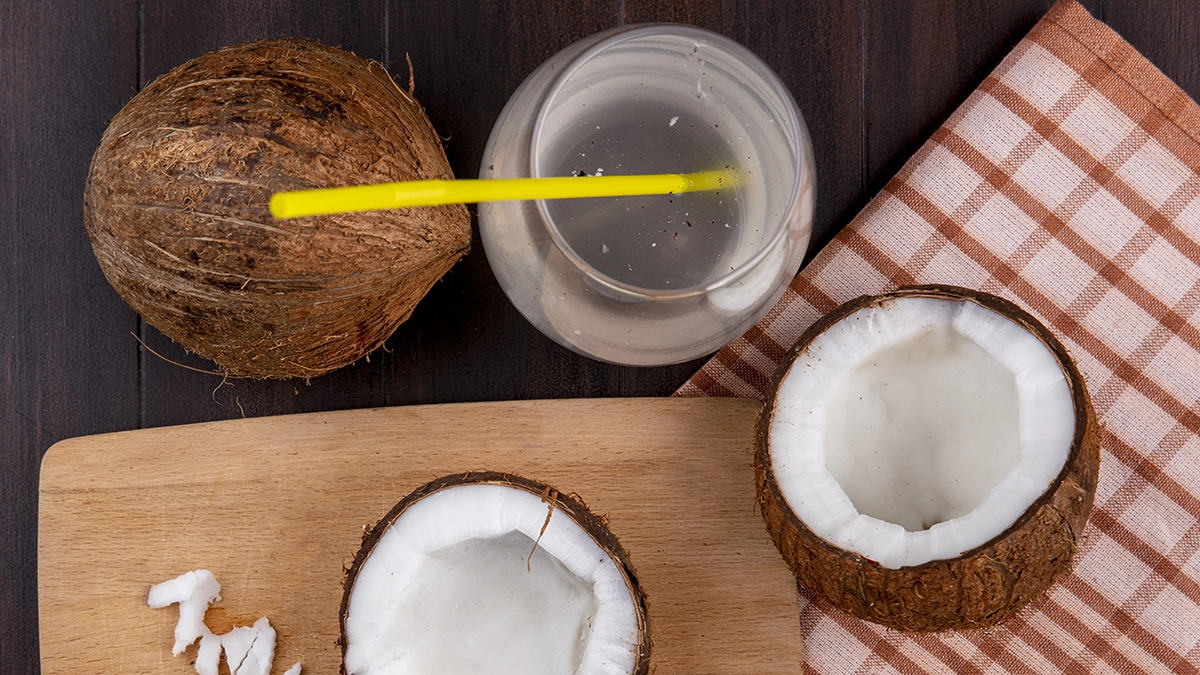
In addition to essential oils, several other natural remedies can complement the treatment of HFMD. These remedies provide holistic support and can enhance the overall effectiveness of essential oil treatments.
Coconut Water
Coconut water is an excellent hydrating agent for children suffering from HFMD. It soothes the throat and provides essential electrolytes, which are crucial for maintaining hydration during the illness.
Frozen coconut water cubes can also help soothe pain and discomfort while preventing dehydration due to their high potassium and electrolyte content.
Epsom Salt Baths
Epsom salt baths can provide significant relief from the pain and discomfort caused by HFMD blisters and rashes. Soaking in an Epsom salt bath helps reduce inflammation, detoxify the body, and alleviate discomfort.
Ginger Root Tea
Ginger root tea is known for its anti-inflammatory properties, which can help alleviate pain associated with HFMD.
Additionally, ginger root tea can boost the immune system, aiding in a faster recovery from the disease.
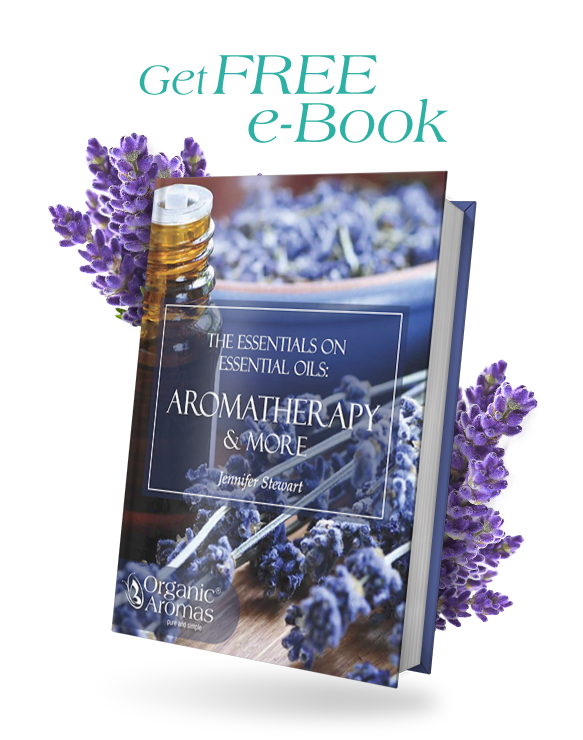
Sign Up to Get Your FREE
e-Book Here…
When to Seek Medical Help
Although natural remedies can provide substantial relief, recognizing the need for medical help is of utmost importance. Seek medical attention if symptoms are severe, if the affected person is very young, or if symptoms persist beyond a few days.
Persistent Symptoms
Persistent symptoms such as excessive tiredness, drowsiness, or irritability may require medical intervention. Additionally, if there are signs of dehydration, such as not passing urine as often as usual, immediate medical advice should be sought.
Severe Cases
Severe cases of HFMD may present with rapid breathing, abnormal movements, or excessive irritability, indicating the need for immediate medical attention. Rare complications affecting the heart, brain, lungs, or eyes also necessitate urgent healthcare intervention.
Final Thoughts: Essential Oils for Hand Foot Mouth Disease
In navigating the challenges of Hand Foot Mouth Disease (HFMD), understanding the symptoms and risk factors is crucial. HFMD, primarily affecting young children, manifests through fever, sore throat, mouth sores, and rashes on the hands and feet. Recognizing these symptoms early can lead to better management and relief.
Essential oils like lavender, tea tree, and lemon offer natural, effective ways to alleviate HFMD symptoms. These oils, known for their anti-inflammatory, antiviral, and soothing properties, can be safely used when diluted with carrier oils, diffused, or applied topically. DIY blends provide targeted relief, while additional natural remedies like coconut water, Epsom salt baths, and ginger root tea further support recovery.
Always remember to seek medical help if symptoms persist or worsen, especially in severe cases. Combining natural remedies with professional medical advice ensures a holistic approach to managing HFMD, promoting comfort and healing for those affected.

Join Our Exclusive Member Club to get Big Discounts!
Frequently Asked Questions
Is There a Cure for HFMD?
There is currently no cure for Hand Foot Mouth Disease (HFMD). Treatment focuses on relieving symptoms, such as fever, sore throat, and painful sores. Over-the-counter pain relievers, plenty of fluids, and soothing mouth rinses are commonly used to manage symptoms. Most cases of HFMD resolve on their own within 7-10 days.
How can essential oils help relieve HFMD symptoms?
Essential oils such as lavender, tea tree, and lemon can provide relief from HFMD symptoms by reducing inflammation, soothing blisters, and disinfecting affected areas.
How should essential oils be used safely for HFMD?
To use essential oils safely for HFMD, it’s important to dilute them with carrier oils, use a diffuser, or apply them topically with caution, especially in children.
What are some additional natural remedies for HFMD?
You can try coconut water, Epsom salt baths, and ginger root tea as additional natural remedies for HFMD, to complement essential oil treatments. These remedies can provide relief from symptoms and support the immune system.
When should I seek medical help for HFMD?
You should seek medical help for Hand, Foot, and Mouth Disease if the symptoms are severe, persistent, or if the affected person is very young. Immediate medical attention is necessary in case of persistent fever, excessive tiredness, or severe symptoms like rapid breathing and abnormal movements.
- Lee, M., Lim, S., Song, J., Kim, M., & Hur, M. (2017). The effects of aromatherapy essential oil inhalation on stress, sleep quality and immunity in healthy adults: Randomized controlled trial. European Journal of Integrative Medicine, 12, 79-86.
- Carson, C., Smith, D., Lampacher, G., & Riley, T., 2008. Use of deception to achieve double-blinding in a clinical trial of Melaleuca alternifolia (tea tree) oil for the treatment of recurrent herpes labialis.. Contemporary clinical trials, 29 1, pp. 9-12
- Zouhir, A., Jridi, T., Nefzi, A., Hamida, J., & Sebei, K., 2016. Inhibition of methicillin-resistant Staphylococcus aureus (MRSA) by antimicrobial peptides (AMPs) and plant essential oils. Pharmaceutical Biology, 54, pp. 3136 – 3150.

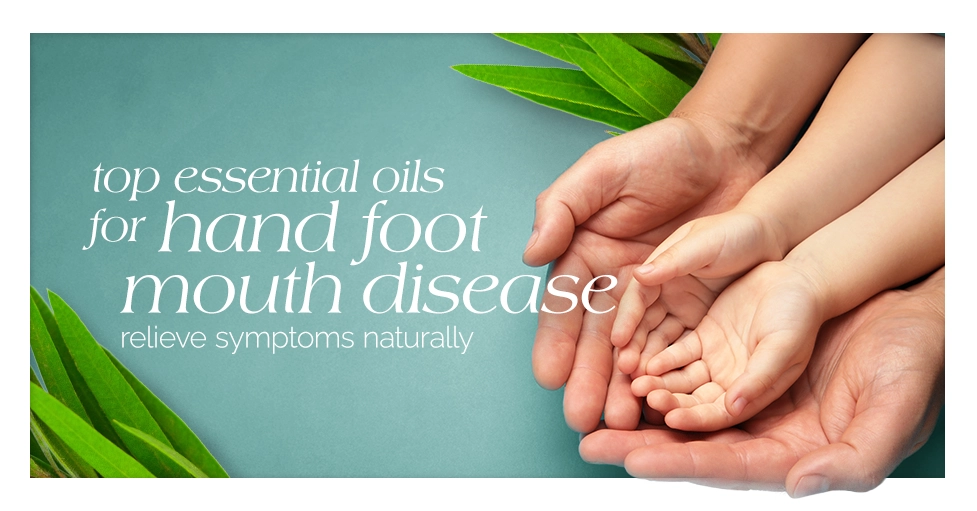
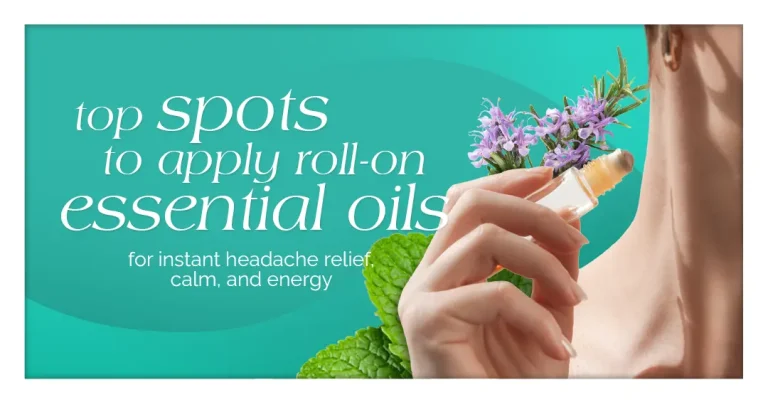
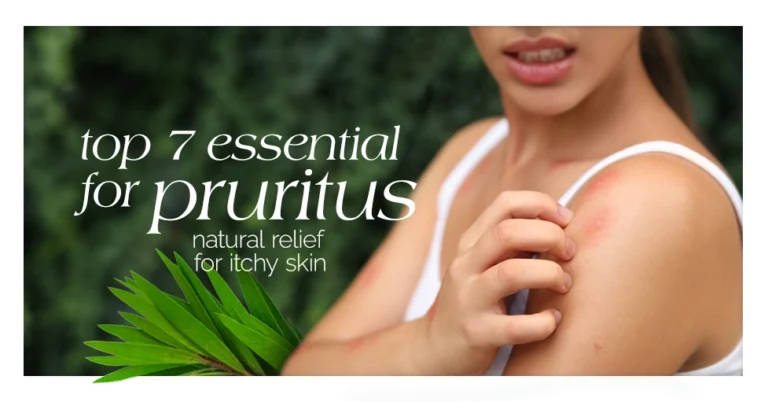




Wonder why they chose this disease to talk about?